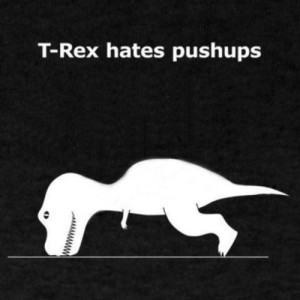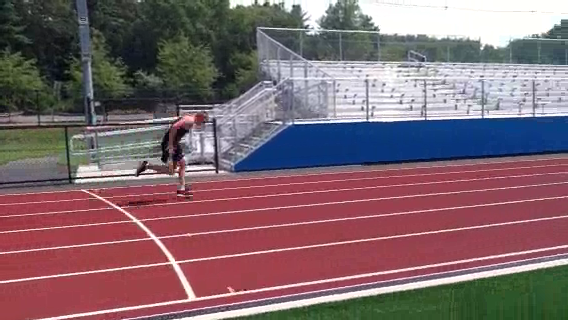A fellow coaching friend asked me this simple question the other day.
Do you cue neck/head position in a sprint?
My answer: It depends on if the position is faulty in the first place, and if so, why the neck is aberrant.
Anyone can see this isn’t good neck/head posture for a start, but what things do you work on to fix it? 
First off, you don’t cue stuff you don’t need to. This is actually a big part of this athlete’s problem that I’ll talk about more below. Being careful with your cueing and exercise choices is particularly important in more athletic tasks like sprinting and jumping. What may produce the results you are after in one athlete, may be an unneeded exaggeration that creates problems where there were none for another. Sometimes cueing may get you closer to the surface aesthetic result you want acutely, but often at it’s at the expense of other moving parts or tightness where there shouldn’t be.
Going back to the picture above, if there is a genuine error, Is it an action error? General movement/skill insufficiency? Physical posture flaw? Or somewhere in the middle?
Head protruding and down like t-Rex in the picture above is a common problem early in accel (head more acute to the ground than shin and trunk angles).

With a head like that, T-Rex wouldn’t have been good at block starts either (I gave my wife this T-shirt and it’s awesome)
Ironically, for those trying to “get low” the head down error makes shin angles more vertical to compensate for the forward and lower center of mass (the athlete has to step forward or laterally not to fall flat on their face). In an attempt to create good angles to push from, they destroy them and also create other problems. Common accompanying issues include a lack of vertical force or bounce with the early steps and extra energy used recovering from the inefficient postures and strikes. These errors haunt the athlete later in the race and in energy distribution over multiple runs.

If your shin is almost vertical at step 4 (like above) in a 100m race that is a lot of the race left to be upright.
This athlete is usually near the front early so many would call him a “good starter,” but when running against other good talents he pays the price for his start mechanics and fades late in races.
Part of the issue for this particular athlete is he’s been over cued, like many young sprinters, to “keep his head down” and “stay low” (sometimes it can work to overstate a cue, but you have to be careful). Part of his neck/head and posture issues are attributed to simply just bad cueing. In this case talking to the athlete and realizing the misunderstanding or flawed concept is the first step. He has to understand the error (sometimes showing them a video or pic helps them realize the head down isn’t working even if it feels low) and then over time rid himself of the technical virus. As a coach you provide patient feedback as he works on improving the issue and developing a new pattern. This often takes time particularly when it comes to executing consistently in higher arousal scenarios like competition.
The other part of the equation is ensuring the athlete has the basic general strength and movement skills to support the needed posture. This athlete has a hard time stabilizing his head in relevant general strength activities as it protrudes and goes Mr. Burns in pushups, basic prone exercises, and classical pushing and pulling movements. Humans have longer arms so he’s not in the predicament of T-Rex, but his pushup posture looks much like his upper back and head in the first pic.
Overall, he needs lots of well coached general strength work to provide him a platform to execute good postures in more dynamic activities. However, if he just worked on the support end you wouldn’t see things change much. As is often the case it’s an interplay between improving support qualities and improving technical sport skill as the two grow in harmony.
An excellent acceleration resource is this DVD by Kebba Tolbert

En Generalmente
Going back to my friends original question, you only cue if you need to! It’s often cases of a bad technical motif or general developmental gaps that have led to faulty technique. Sometimes errors in force application are more a cause of the posture than simply the athletes positioning. Outside of undoing bad concepts in acceleration, most often I’ve battled positional faults due to ineffective fights against gravity (the upper back and neck actually have to extend from the start position and counter gravity) and simply teaching folks patience not to look artificially down or up with premature movements of their neck (patience is huge in acceleration).
Faults in neck and head posture in upright mechanics or top speed are most often due to undue tension or bad posture elsewhere in the body. Relaxation cues and general posture cues are usually the course for upright running. Forced or over coached postures tend to be restricted postures that tie up the athlete.
If the athlete has general posture issues I find they are best addressed via training and execution in a variety and sufficient volume of general training scenarios (manual therapy is nice too). Daily life stuff for the head and neck is more of a problem than ever and kids need to be educated on how to mitigate the damage from big chunks of time spent computing, IPading, and texting.
Making changes to head and neck posture in sprinting is usually a match step process of development. As is always the case, well coached complete programs executed over the long haul produce the most competent and complete athletes.
FOLLOW US FOR MORE -SHARING IS CARING -




Speak Your Mind